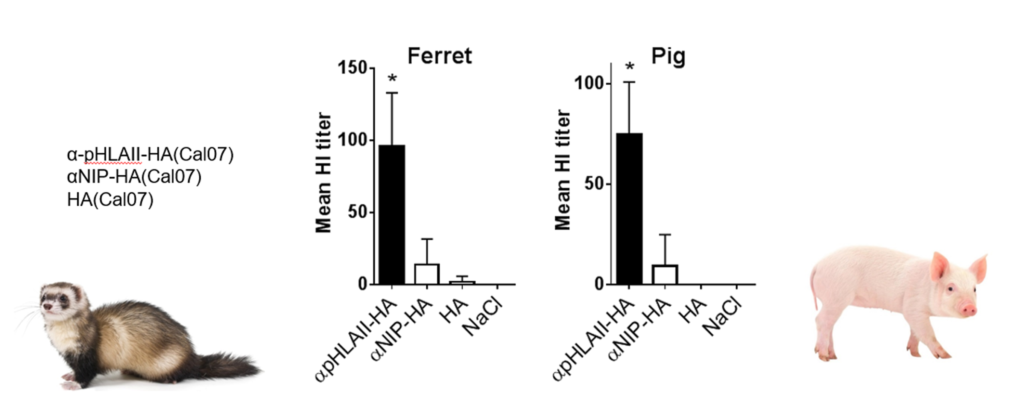Our team at Oslo University Hospital and University of Oslo has developed a novel targeting sequence that allows for direct targeting of vaccine antigens to immune cells, thereby improving the immunogenicity and efficacy of subunit vaccines. While the technology can be used to improve a wide variety of vaccines, the team has used influenza as model pathogen.
BUSINESS OPPORTUNITY
We currently seek to partner with organizations who can support the continued development of our HLA-II targeting vaccine platform. The first vaccine incorporating the technology is about to enter Phase 1 clinical testing, with results expected Q4-2022. Our platform can be used with several different vaccine technologies, including subunit, DNA, and mRNA vaccines.
TECHNOLOGY
Vaccines have traditionally made use of inactivated or weakened bacteria or viruses to elicit protective immunity. However, due to safety concerns, this strategy cannot be implemented for all pathogens. Instead, vaccines are often made with selected antigenic subunits from the pathogen in question. However, while improving safety, this approach lowers vaccine efficacy.
Our team has developed a novel strategy for targeting subunit antigens to specific immune cells, using a novel targeting sequence that binds almost all MHC-II (HLA-II) molecules. In this way, the immunogenicity of subunit vaccines can be improved. Previous attempts at targeting vaccine antigens to MHC-II have been hampered by the inherently high variability of MHC-II molecules. With our broadly acting targeting unit, this challenge is overcome.
Proof of principle for the technology was obtained by immunizing ferrets or pigs, respectively, with a DNA-based influenza vaccine containing antigen with or without targeting. Importantly, we have demonstrated that a single DNA vaccination in larger animals is sufficient for raising neutralizing antibodies against influenza. With targeting, the animals produced high levels of neutralizing antibodies against influenza. Thus, the targeted approach was superior to non-targeted antigens (please see figure below; Grødeland et al, J. Immunol, 2016).

PUBLICATIONS
- Grodeland G, Fredriksen AB, Løset GÅ, Vikse E, Fugger L, Bogen B. Antigen Targeting to Human HLA Class II Molecules Increases Efficacy of DNA Vaccination. J Immunol. 2016 Nov 1;197(9):3575-3585. doi: 10.4049/jimmunol.1600893. Epub 2016 Sep 26. PMID: 27671110; PMCID: PMC5073356.
- Mooij P, Grødeland G, Koopman G, Andersen TK, Mortier D, Nieuwenhuis IG, Verschoor EJ, Fagrouch Z, Bogers WM, Bogen B. Needle-free delivery of DNA: Targeting of hemagglutinin to MHC class II molecules protects rhesus macaques against H1N1 influenza. Vaccine. 2019 Feb 4;37(6):817-826. doi: 10.1016/j.vaccine.2018.12.049. Epub 2019 Jan 9. PMID: 30638800.
- Grødeland G, Baranowska-Hustad M, Abadejos J, Blane TR, Teijaro J, Nemazee D, Bogen B. Induction of Cross-Reactive and Protective Antibody Responses After DNA Vaccination With MHCII-Targeted Stem Domain From Influenza Hemagglutinin. Front Immunol. 2020 Mar 25;11:431. doi: 10.3389/fimmu.2020.00431. PMID: 32269566; PMCID: PMC7112135.
INTELLECTUAL PROPERTY
- WO/2017/221072 (priority date: 21.06.2016) is owned by University of Oslo and Vaccibody AS. This application has entered national phase (pending) in USA, Europe, and India.
- WO/2019/048936 (publication date: 07.09.2017) is owned by University of Oslo. This application has entered national phase (pending) in Europe.


